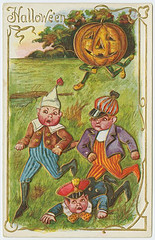Future Now
The IFTF Blog
How Our Perception of Risk Hurts our Health

When we explain how misinformation can spread through society, my colleague, Bradley Kreit, sometimes uses the example of killer Halloween candy. Various versions of this story exist, some with a pretty elaborate setup, like one in which an escaped mental patient murders a family on Halloween night and then proceeds to take their Halloween candy, poisons it and then hands it out to unsuspecting kids. Another involves deranged hippies dosing innocent, fair-haired children with "the drugs" in an attempt to control their minds. Many versions of the story involve kids eating chocolate bars which someone had put a little razorblades or needles in. The one thing these stories have in common, though, is that none of them are true. At this point, most people know it's an urban legend, yet countless parents are still fearful about their children's trick-or-treat candy. Many of these same parents, though, don't have the same level of anxiety over what their kids ingest on days other than Halloween, despite rising rates of heart disease in adults and diabetes in both adults and children. In short, people misperceive risk and it has a number of consequences for health.
A lot of people have looked at this problem from different angles. Rebecca Costa, author of “The Watchman’s Rattle,” for instance, takes a biological view, explaining that we evolved with a (once) healthy fear of heights and snake bites, impulses that served us well in our early days, but are completely out-of-sync with our current health concerns—people irrationally fear flying and not driving; and snakes are a good way to control the population of disease-carrying rodents. Costa explains that most people get an involuntary chemical fear response upon seeing a snake, but studies have shown you can explain to someone how climate change is destroying the planet and "their heart rate doesn't go up one beat per hour.”
“You're not genetically designed to respond to long term danger—even if that danger is catastrophic."
Things which provokes the greatest visceral fear response, like our children ingesting razor blades, gains traction in society more quickly and deeply.
(Dan Gardner, Simon Briscoe and Hugh Aldersey-Williams have done similar work)
Costa also chalks some of our misperceptions up to information overload. The uncertainty that exists today, she argues, cause many to turn to the people who seem the most certain, even if they are demonstrably wrong. (Our own distinguished fellow, Bob Johansen, explores this concept in his book Get There Early: Sensing the Future to Compete in the Present—he sees the popularity of words like "definitely," and "absolutely" in conversations today as a sign of our desire for certainly in uncertain times).
While Costa focuses on some pretty massive consequences of our inability to asses risk—such as creating wrong-headed government policy and destroying our planet— Gever Tulley, founder of the TInkering School and a speaker at IFTF's recent Tech Horizons conference, looks at some of the smaller, but still important problems this creates, in his TED talk, the “5 Dangerous Things You Should Let Your Kids Do.”
He sees this issue as more social than biological, as he argues that concepts of danger are culturally constructed. He's created a term, "dangerism," for systems of belief about danger.
"I have had a lot of discussions with parents about which risky activities they will and won’t let their children participate in, and the differences are often striking," he explained on his blog. "Just as there is no necessarily rational basis for choosing which animals are eaten, there appears to be no rational basis for deciding what activities are acceptable for children."
So to go back to the Halloween candy example, what are the health consequences of this "dangerism," this culture that perceives danger in Halloween candy?
One might say, "none, really." Halloween is a little less fun and a little more sanitized. But, as Brad has often pointed out, trust and social cohesion are among the world's best medicines. According to an article Brad shared from the New Scientist, John Cacioppo of the University of Chicago, an expert on the effects of social isolation has found that "being lonely increases the risk of everything from heart attacks to dementia, depression and death, whereas people who are satisfied with their social lives sleep better, age more slowly and respond better to vaccines."
And here's where the health consequences of fearing that your neighbors will poison your kids comes in:
Crucially, these differences relate most strongly to how lonely people believe themselves to be, rather than to the actual size of their social network. That also makes sense from an evolutionary point of view, says Cacioppo, because being among hostile strangers can be just as dangerous as being alone. So ending loneliness is not about spending more time with people. Cacioppo thinks it is all about our attitude to others: lonely people become overly sensitive to social threats and come to see others as potentially dangerous.
Essentially, rearing your kids to fear their neighbors makes them "overly sensitive to social threats" and leads the to "see others as potentially dangerous." So maybe the biggest danger at Halloween, more than the long-term health effects of annual Halloween candy indulgences and certainly bigger than cyanide-spiked Tootsie Rolls, is teaching mistrust.



